
The
transport of refined oil products in 2004
The freight market
Handysize
Medium
Range
Long Range
Demand for shipping
Second-hand market
see also
The
crude oil transport
|
|
For the second year in a
raw, 2004
will remain a memorable year for owners, since the market
for product tankers registered an increased level of
average daily returns. There
has been a progress of over 20 % for all size of ships both
for spot and period business.
As in 2003, the
exceptional rise in this market has been due to the high level of growth in the US and
the Far East, even if the development of the
"paper" market, aided by some speculation
particularly on the TC1 (75,000 mt naphtha Middle East Gulf
/ Japan) and the TC2 (33,000 mt UMS Continent / US Atlantic
Coast) routes, helped contribute to the strong performance
of the freight market.
The rise in rates, which began in
December 2003, peaked in February, with daily returns
approaching $ 40,000 per day. The drop registered in the
months of March and April corresponded to an easing in the
fuel oil market, before rates started to perk up again in
May and June at around $ 25,000 per day. The traditional low
point in the summer was around $ 20,000 per day and the
expected recovery came at the beginning of October, which
allowed the Medium Range product carriers (MR) to enjoy once
again returns of $ 40,000 per day, whereas the Long Range
(LR) were flirting with the $ 60,000 per day level.
Like last year, the rates paid for period
charters were largely lagging behind the spot market.
Nonetheless, if charterers were reticent about committing
themselves to long term business at high levels, they
accepted to pay record levels for shorter periods and
started using floating rates agreements indexed on the spot
market or linked to a profit sharing scheme.
However, whilst the market was able to
absorb the some 130 MR ships, totalling 5.5 million dwt
delivered in 2004, there is some doubt as to the chances of
repeating this exploit in 2005, 2006, and 2007'
|
|
The evolution of
product tanker freight rates in 2004
|
|
Yields for Handysize ships
surpassed those obtained in 2003 by more than 20 % at nearly
$ 25,000 per day, despite the "ice class" premium being
virtually non-existent due to the mild winter season which
started in 2004. Whilst these ships were most frequently
employed in the Atlantic zone, some started to find
employment around the Far East, especially the "shallow
draft" units with a capacity of 45,000 cbm.
|
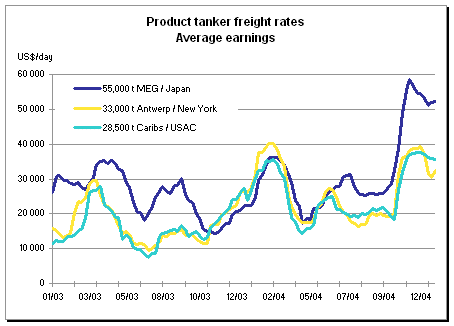
|
|
Within the European zone,
both in North Europe as well as in the Mediterranean - Black
Sea area, over half of the fleet was used once again in the
transport of fuel oil and crude, with owners not hesitating
to switch from clean to dirty and vice-versa, based on the
rates differentials that could be obtained respectively in both
sectors.
Charterers were not really keen to commit
themselves to long period business due to the high
expectations of owners, but starting in October and facing a
strong surge in spot rates, they finally had to accept
paying levels above $ 20,000 per day for periods of 12 to 18
months.
|
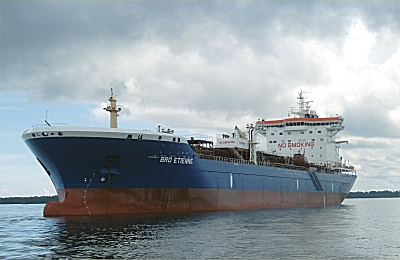
|
Bro Etienne
37,179 dwt, delivered in 2004 by Jinling, owned by Brostr'm Tankers |
|
|
Ships operating in the Atlantic benefited
from the sustained level of American demand for gasoline and
fuel oil. Daily returns for a 33,000 t voyage - UMS -
Continent / US, varied between $ 16,250, at the bottom of
the market during the summer, to $ 40,000 per day in
February and December, with the annual average working out
at $ 26,500 per day.
Parallel to this, a traffic of gas oil
developed between the US Gulf and Europe. In 2004 Europe
imported 11.5 million barrels of gas oil from the US, which
is the equivalent of 13 % of the American production.
As in 2003, ships operating in the East
of Suez took advantage of the economic strength of the Far
East zone, led by the growth in China, India, and Japan.
Despite a seasonal decline in the spring, returns remained
comfortably above $ 20,000 per day, notably after the month
of October.
Long term period business was scarce, but
traders such as Vitol, Trafigura, and especially Glencore
were very active in the short period business (3 to 12
months) and did not hesitate to pay rates above $ 30,000 per
day to the extent that they were able to hedge their
positions on the "paper" market.
|
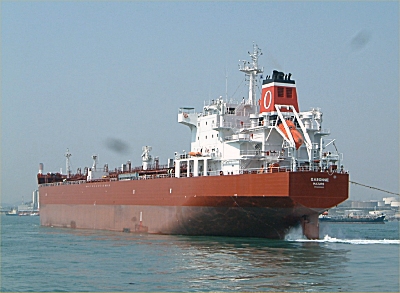
|
Garonne
37,178 dwt, delivered in 2004 by Hyundai Mipo, operated by OMI Corp. |
|
|
The LR2 and the LR1 were also
particularly helped by the strong demand coming from
throughout the Far Eastern zone, notably China and Japan. As
from mid-September, daily returns went from $ 30,000 to $
60,000 per day for the LR1, whereas the LR2 were over $
70,000 per day.
In this sector of the market, the
"paper" business has an important role, but if the
route TC1 (LR2 - 75,000 mt - Middle East Gulf / Japan) was
heavily traded at the beginning of the year, it soon became
obvious that the market was far more liquid on the TC5 route
(55,000 mt - Middle East Gulf / Japan).
The market was also well supported by the
numerous movements of kerosene from the Middle East Gulf to
Europe and by the European exports of distillate and
gasoline to the US.
Some long term period business was
concluded on ice-class LR2 ships, but it was the LR1 size
which was being sought after for trading clean products,
fuel oil and crude. The majority of these fixtures were done
in the first half of the year, which explains why the rates
were around the $ 22,000 / 23,000 per day for periods of 3
years.
Despite the large number of new ships
being delivered, 2005 should again be a year favourable to
owners of product tankers. Even with a considerable increase
in modern tonnage, the complete renewal of the fleet will be
far from being accomplished by the end of 2005.
Delivery of new ships should result
in:
-
ships from 30 to 40,000 dwt: 48 ships
totalling 1.75 million dwt,
-
ships from 40 to 55,000 dwt: 78 ships
totalling 3.70 million dwt,
-
ships from 55 to 90,000 dwt: 40 ships
totalling 2.75 million dwt, to which will be added some
20 coated Aframax tankers totalling nearly 2.0 million
dwt.
Supply of tonnage will therefore increase
significantly especially since the demolition level is low.
At current rates, even the simple decision to put a vessel
in technical lay-up is to be taken by the top management of
the company. Notwithstanding, at the end of 2005, the
Major's eligible fleet will only comprise some 650 ships for
a little less than 30 million dwt against over 950 ships and
35.0 million dwt at the beginning of 1999.
|
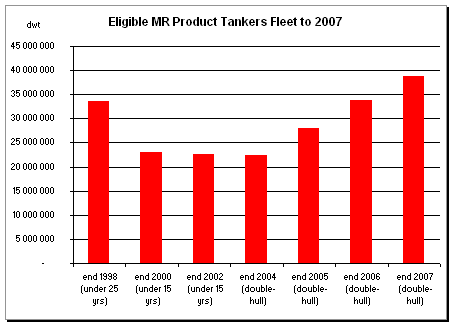
|
|
The withdrawal of the older ships has
been postponed due to the fact that certain niche business
continues to be very remunerative: gas oil movements from
the Black Sea, clean products for West Africa or even the
market for vegoils and molasses. In addition, the high
freight levels have convinced several owners to undertake
necessary refitting work to obtain the mandatory
certificates (C.A.S. / CAP 1 or 2), which will allow them
to operate their ships beyond their twentieth anniversary.
(C.A.S.=Condition
Assesment Scheme)
Nonetheless the international safety
measures and the vetting services of oil companies continue
to put pressure on owners of old vessels, whose days are
numbered. We predict therefore that demolition will
gradually increase throughout the coming year.
|
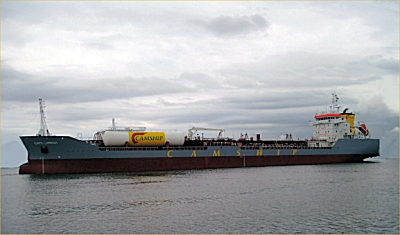
|
Cape Limboh
15,305 dwt, built in 2003 by Okean shipyards for Petromarine |
|
|
Demand for shipping
of clean and dirty products bound to the American zone or
the Far East has been, like in 2003, the main factor
maintaining the healthy state of the freight market.
Once again, it was the fuel oil market in
the Atlantic zone which sparked off the rise in rates in
mid-September. At the end of November only, rates obtained
by the clean products have catched up with the levels achieved by
fuel oil and crude. The clean products followed this trend a
month later and they were able to match and then overtake
the dirty product rates only by the end of November.
In the Far East, the increase in rates
started at the beginning of September, namely two months
earlier than usual. Then the very high levels tended to
tumble, as much due to lack of available tonnage as due to
technical shutdowns at several refineries in the Middle East
Gulf.
However, the fundamental
explanation is the continuing high level of imports, resulting from
a lack of local refineries able to meet domestic demand in
oil products. It is known that in the US ecological factors
are curbing the expansion of refinery capacity and that the
increase in capacities are not keeping pace with the demand in the Far
East.
Under these conditions, the demand for
transport of refined oil products should continue to
increase in 2005, especially as the trend toward longer
trade routes is likely to continue. There are even some
projects being carried out to transport naphtha and
condensate from the Mediterranean to China!
***
As we stated last year, "it is
unavoidable that the large number of vessels being delivered
in the next 2 to 3 years will affect the product tankers
market". One can add that there has been some doubt
expressed recently as to the persistence of the American
growth and the reliability of the Chinese expansion (at the
current pace of 9.5 % per year, the Chinese economy will
double within 6 years)'.and finally cannot exclude the
risk of a financial crisis in the Asian zone.
Nonetheless, except a major event, the year 2005 gives every
sign of being propitious to product tankers owners. The
arrival of over a hundred new ships should however dampen
the volatility of the market and cause a modest drop in the
daily average returns.
|
|
|
The product tankers
second-hand market
|
|
The steady rise of product tankers
freight rates during the year 2004 also had an impact on
second-hand values. In a higher volume of transactions
(around 150 Medium Range and Handy product tankers built
since 1980 have changed hand in the course of the year)
prices have dramatically risen.
The value of a five year-old standard
double-hull 45,000 tonner, which was around $28 million at
the end of 2003, progressed to $32 million by the end of
June and up to an average of $39 million in December.
This rise also applied to the older units
as, for instance, the value of a 20 year, single-hull,
45,000 dwt started at around $5 million in January 2004, to
reach $7 million at the end of June and ended the year at
around $9 million.
Lastly, a single-hull 40,000 dwt product
tanker built at the end of the 1980's, for which one had to
spend $11.5 million at the end of 2003, ended the year at
around $16 million.
|
Shipping and Shipbuilding Markets in 2004
I N D E X
|